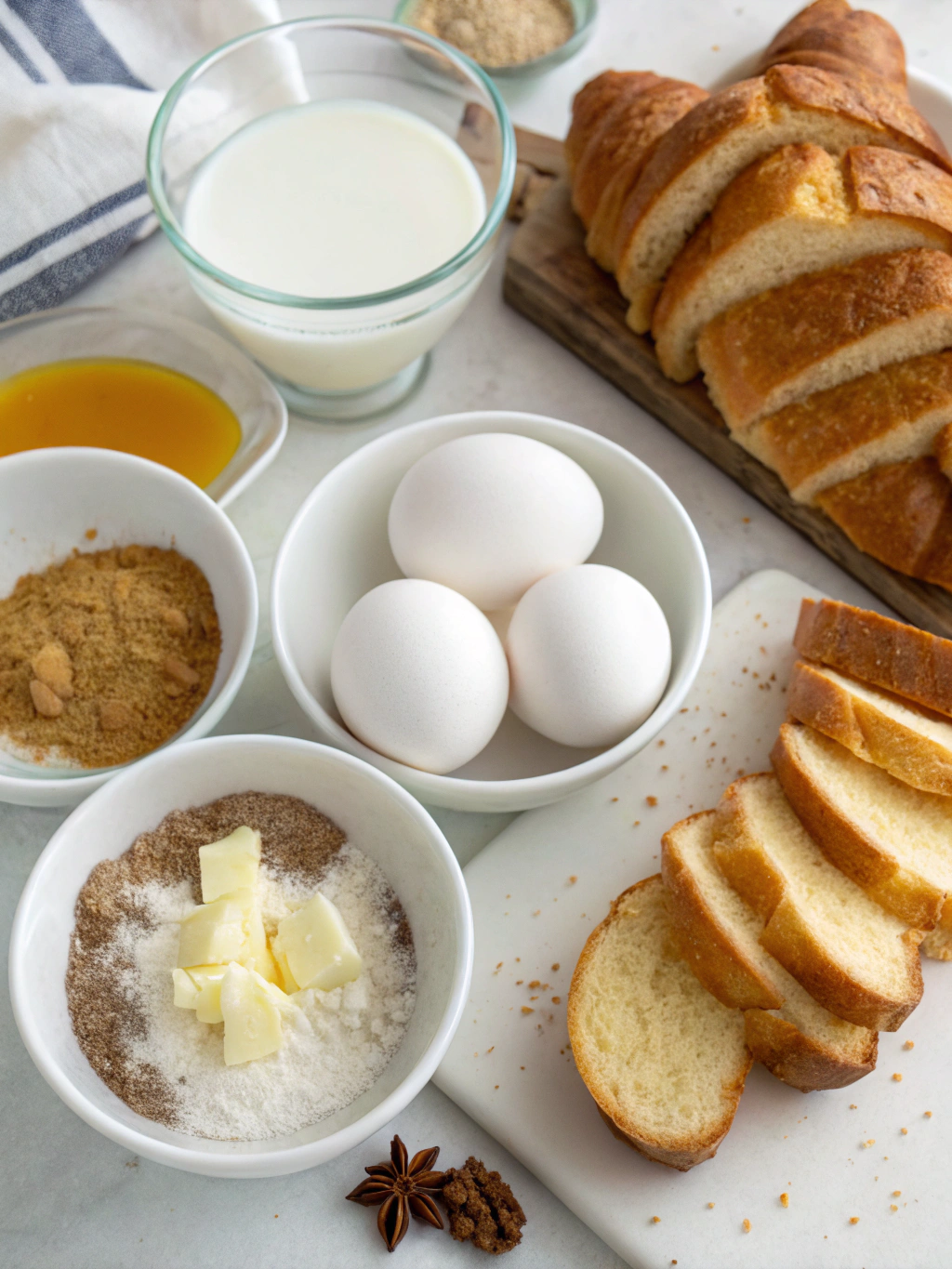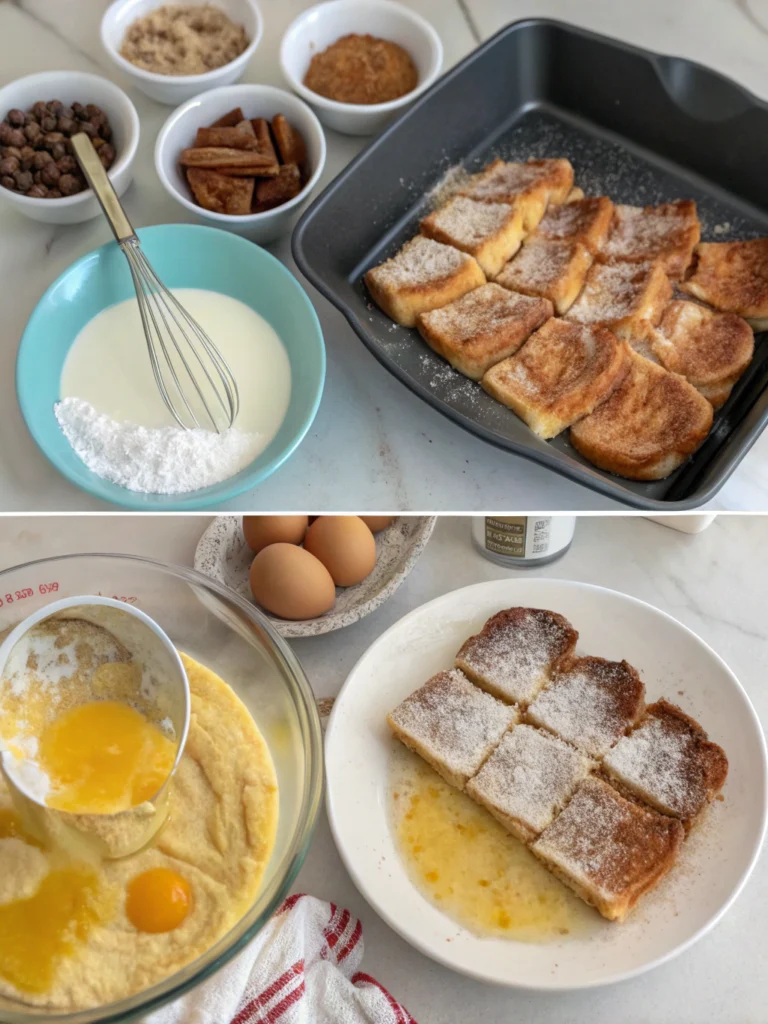Ever wondered why restaurant Croissant French Toast tastes so divine while yours falls flat? What if the secret isn’t fancy ingredients but simply using croissants instead of regular bread? This game-changing breakfast transforms ordinary mornings into special occasions with minimal effort.
The buttery, flaky layers of croissants elevate traditional French toast to new heights. When soaked in a rich custard and perfectly caramelized, Croissant French Toast delivers an irresistible combination of crispy exterior and tender, pudding-like interior that will revolutionize your breakfast routine.
Already love oatmeal pancakes? Then you’ll fall for our Pumpkin Pancakes, the perfect mix of comfort and seasonal spice!
Ingredients List

- 4 large day-old croissants, sliced horizontally (substitute with brioche if unavailable)
- 4 large eggs, at room temperature for better absorption
- 1 cup whole milk (substitute with almond milk for a dairy-free option)
- 1/4 cup heavy cream (coconut cream works for dairy-free)
- 3 tablespoons granulated sugar (or maple syrup for a less processed option)
- 1 tablespoon pure vanilla extract (or 1 vanilla bean, seeds scraped)
- 1 teaspoon ground cinnamon (freshly ground for more vibrant flavor)
- 1/4 teaspoon freshly grated nutmeg
- Pinch of salt (balances sweetness perfectly)
- 2 tablespoons unsalted butter for cooking (plus more as needed)
- Maple syrup, fresh berries, and powdered sugar for serving
Timing
- Preparation time: 15 minutes (plus 30 minutes soaking time for deeper flavor penetration)
- Cooking time: 10 minutes (30% faster than traditional French toast due to croissants’ porous texture)
- Total time: 55 minutes (most of which is hands-off, allowing you to prepare other breakfast items)
Step-by-Step Instructions

Step 1: Prepare Your Croissants
Slice your day-old croissants horizontally to create top and bottom halves. Slightly stale croissants work best as they absorb the custard without falling apart. If your croissants are fresh, place them in a 250°F oven for 10 minutes to dry them slightly.
Pro tip: Day-old bakery croissants are often sold at a discount, making this recipe both delicious and budget-friendly!
Step 2: Create the Perfect Custard Mixture
In a large, shallow bowl, whisk together eggs, milk, heavy cream, sugar, vanilla extract, cinnamon, nutmeg, and salt until completely combined. The consistency should be smooth with no visible egg whites remaining.
For an extra layer of flavor, add a tablespoon of orange zest or a splash of Grand Marnier if making this for a special brunch occasion.
Step 3: Soak the Croissants
Place the sliced croissants in the custard mixture, allowing each piece to soak for 2-3 minutes per side. Unlike regular bread, croissants absorb the mixture quickly due to their honeycomb-like interior structure.
For the best way to make croissant French toast, avoid over-soaking, which can make them too fragile to handle. The croissants should feel heavy but still maintain their shape when lifted.
Step 4: Cook to Golden Perfection
Heat a large non-stick skillet or griddle over medium heat. Add 1 tablespoon of butter and allow it to melt completely, coating the cooking surface.
- Place soaked croissant pieces on the hot surface, being careful not to overcrowd the pan.
- Cook for 3-4 minutes on the first side until golden brown and crispy.
- Flip carefully using a thin spatula and cook for another 2-3 minutes on the second side.
- Add more butter between batches as needed.
Watch the heat carefully – the sugar in the custard can burn quickly. If your toast is browning too fast, lower the temperature slightly.
Step 5: Serve with Style
Transfer your Croissant French Toast to warmed plates. Dust with powdered sugar using a fine-mesh sieve for an even, professional-looking coating.
Drizzle with warm maple syrup and garnish with fresh berries, a sprig of mint, and a dollop of whipped cream for a restaurant-quality presentation that will impress family and guests alike.
Nutritional Information
Each serving (1 croissant/2 halves) contains approximately:
Calories: 450 kcal (22% of daily recommended intake)
Protein: 12g (24% of daily recommended intake)
Carbohydrates: 42g (14% of daily recommended intake)
Fat: 28g (43% of daily recommended intake)
Fiber: 2g (8% of daily recommended intake)
Sugar: 18g (includes natural and added sugars)
Sodium: 380mg (16% of daily recommended intake)
This indulgent breakfast provides sustained energy through its balance of carbohydrates, proteins, and healthy fats. The egg-based custard adds significant protein value, making this more nutritionally complete than standard toast options.
Healthier Alternatives for the Recipe
For a lighter version that still delivers on flavor, consider these modifications:
Replace whole milk and heavy cream with unsweetened almond milk and Greek yogurt to reduce fat while maintaining creaminess. This swap cuts calories by approximately 30% while adding probiotics.
Use whole-grain croissants if available, which offer more fiber and nutrients than traditional versions. The nutty flavor adds complexity that pairs beautifully with maple syrup.
Substitute granulated sugar with monk fruit sweetener or stevia for a zero-calorie option that doesn’t spike blood sugar. The custard will still caramelize beautifully during cooking.
Top with a homemade berry compote instead of maple syrup to add antioxidants and reduce added sugars. Simply simmer fresh or frozen berries with a splash of water until they break down into a natural sauce.
Serving Suggestions
Elevate your Croissant French Toast with these creative serving ideas:
Create a DIY toppings bar with different syrups, fresh fruits, toasted nuts, and whipped cream for a customizable breakfast experience perfect for weekend family brunches.
For a savory-sweet combination, serve alongside crispy bacon or breakfast sausage. The saltiness perfectly balances the sweet custard-soaked croissants.
Transform leftovers into a bread pudding by cubing them, adding more custard, and baking until puffed and golden. This creates an entirely new dessert from the same ingredients.
For special occasions, drizzle with chocolate ganache and add sliced strawberries for a decadent dessert-like breakfast that still provides balanced nutrition from the egg-based custard.
Common Mistakes to Avoid
- Using completely fresh croissants: They’re too soft and will fall apart when soaked. Day-old pastries have the perfect structure to absorb custard while maintaining integrity.
- Soaking for too long: Unlike hearty bread, croissants need just 2-3 minutes per side. Over-soaking leads to a soggy, impossible-to-flip mess.
- Cooking at high heat: The sugar in the custard burns easily. Medium-low heat ensures even cooking without scorching.
- Flipping too early: Wait until the bottom is truly golden and set before attempting to turn. Patience yields the perfect texture contrast.
- Overcrowding the pan: Leave space between pieces to ensure even cooking and make flipping easier. Crowded pans create steam instead of caramelization.
Storing Tips for the Recipe
While best enjoyed immediately, leftover Croissant French Toast can be stored properly for later enjoyment:
Refrigerate leftovers in an airtight container with parchment paper between layers to prevent sticking. They’ll keep well for up to 2 days while maintaining good texture.
To reheat, avoid the microwave, which makes them soggy. Instead, place on a baking sheet in a 350°F oven for 5-7 minutes until heated through and crisp again.
For meal prep, prepare the custard mixture up to 24 hours ahead and store in the refrigerator. This allows the flavors to meld while saving morning preparation time.
Freeze fully cooked and cooled pieces on a baking sheet, then transfer to a freezer bag. They’ll keep for up to 1 month. Reheat from frozen in a 350°F oven for 10-12 minutes.
Conclusion
This Croissant French Toast recipe transforms an already beloved breakfast classic into something truly extraordinary. By leveraging the buttery, flaky texture of croissants, you create a breakfast that balances crispy edges with a custardy center that’s impossible to resist.
Have you tried this elevated version of French toast? I’d love to hear your experiences, variations, and serving suggestions in the comments below! And if you enjoyed this recipe, be sure to check out our other breakfast transformations that make mornings something to look forward to.
